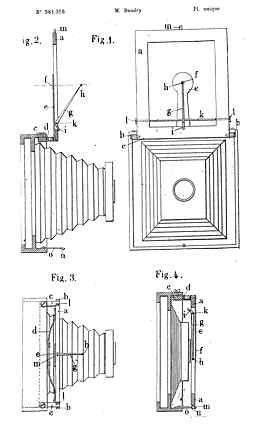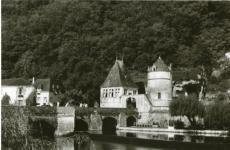|
Baudry Isographe |
Manufactured or assembled in France from 1935 to 1945.
Index of rarity in France: Rare (among non-specialized garage sales)
Inventory number: 10420
See the complete technical specifications
Chronology of cameras Baudry
 Lucien-François Baudry (1886-1950), a watchmaker from Angers, began producing very unique cameras in very limited quantities in the mid-1920s. He was assisted by a single worker from 1918 to 1936. Initially, the components of the cameras were molded from recycled metal before being sent to a foundry for better results. The worker handled the production of the parts, while Lucien Baudry himself was responsible for assembling and fine-tuning each camera. Each unit is nearly unique because L. Baudry continuously made modifications to his creations. The cameras were intended for stereophotography on plates (6 x 13 format). Later models were adapted for film, using 620 film to provide a pair of images in the 6 x 13 format. There are a few single-lens models that were manufactured after the war.
Lucien-François Baudry (1886-1950), a watchmaker from Angers, began producing very unique cameras in very limited quantities in the mid-1920s. He was assisted by a single worker from 1918 to 1936. Initially, the components of the cameras were molded from recycled metal before being sent to a foundry for better results. The worker handled the production of the parts, while Lucien Baudry himself was responsible for assembling and fine-tuning each camera. Each unit is nearly unique because L. Baudry continuously made modifications to his creations. The cameras were intended for stereophotography on plates (6 x 13 format). Later models were adapted for film, using 620 film to provide a pair of images in the 6 x 13 format. There are a few single-lens models that were manufactured after the war.
These cameras are known as "Isographe." In some catalogs, the name "Iso-Roll-Film" is found for the version with film, although it's unclear whether this is a distributor's proprietary name, a naming error, or Baudry's attempt to distinguish the film version.
The quality of craftsmanship is quite exceptional, considering that it was the work of a single individual who operated without formal plans. The shutter is a homemade creation, with the lenses being the only components not made by Baudry.
The silhouette of the Isographe is distinctive. It is a folding camera with a bellows; a small foldable handle allows the front part of the camera to be pulled forward to facilitate its deployment. Some units have a fixed focus, while others have focusing achieved through a micrometric screw linked to the linkage connecting the two lenses. The back is rectangular, and the viewfinder consists of two parts: the front part is a folding metal frame on which two round pieces are fixed. Folding this part of the viewfinder-catch, the two round pieces are positioned precisely in front of the lenses, serving as caps (Patent 581,356 filed on November 27, 1924). The rear part supports an eyepiece.
When setting up the camera, use the small square handle to pull forward and fully extend the bellows. The camera is entirely metallic, except for the leather bellows. The separation between the two dark chambers is made of fabric.
In this model, the two lenses are connected by a link onto which a micrometer screw is attached. Adjusting this screw allows for focusing. Both lenses are Berthiot 4.5/75 mm. The two shutters are coupled without any apparent mechanism. The small scale located to the right, under the lens, determines the aperture.
The selection of the shutter speed is somewhat impractical, as the selection disk is situated under the link synchronizing the lenses. It is graduated from 1 to 200 (hundredths of a second).
The lever positioned between the two lenses is the shutter cocking lever. The shutter release button is the tiny one located on the upper edge of the front face. Beneath it, there is a small prop for horizontally placing the camera.

Interesting links or bibliography :
Add a link or element of bibliography, a picture taken with this camera, a picture of box or an ads about this camera
Your photos taken with the same camera:
Cameras from Ebay France (Baudry) (Uploaded each 3 hours)







